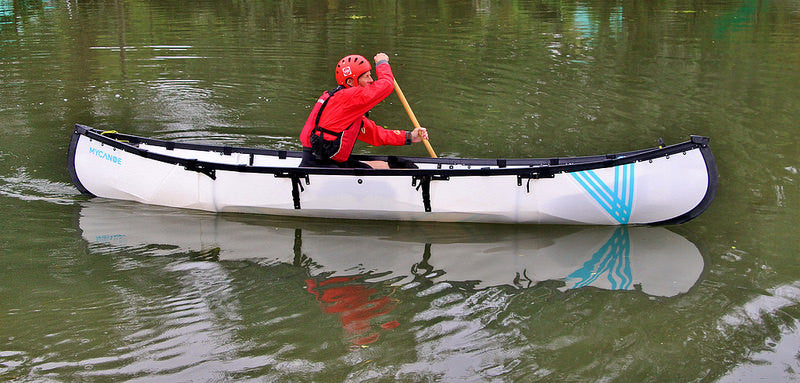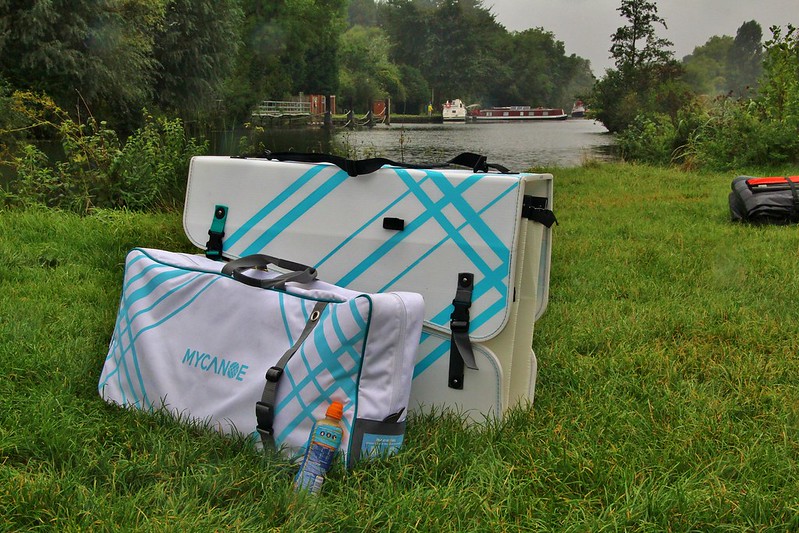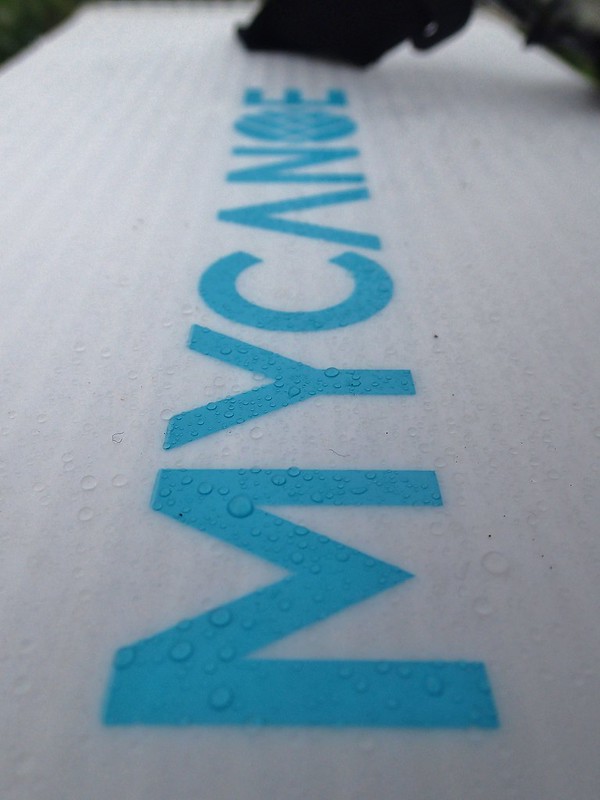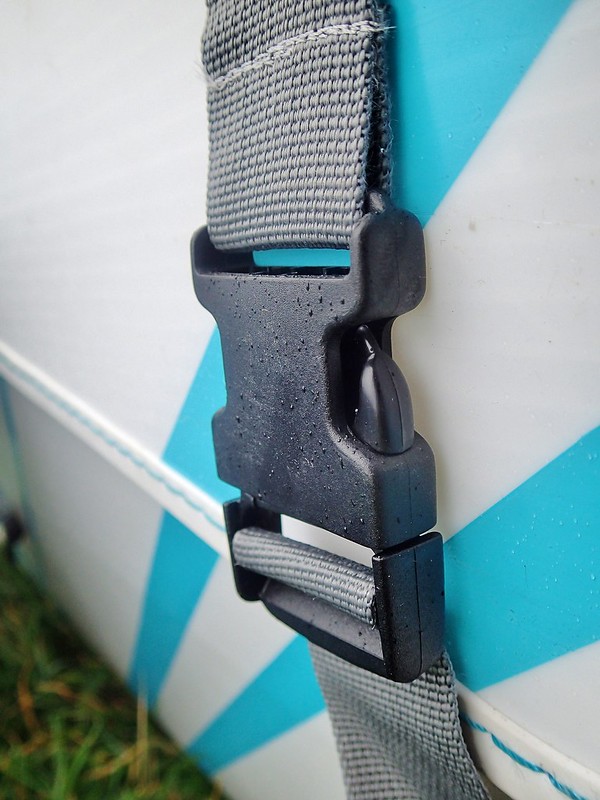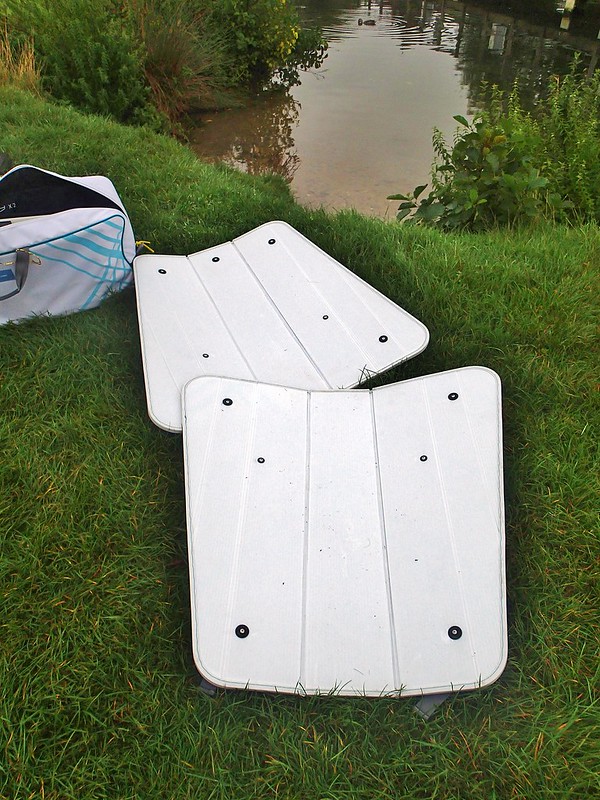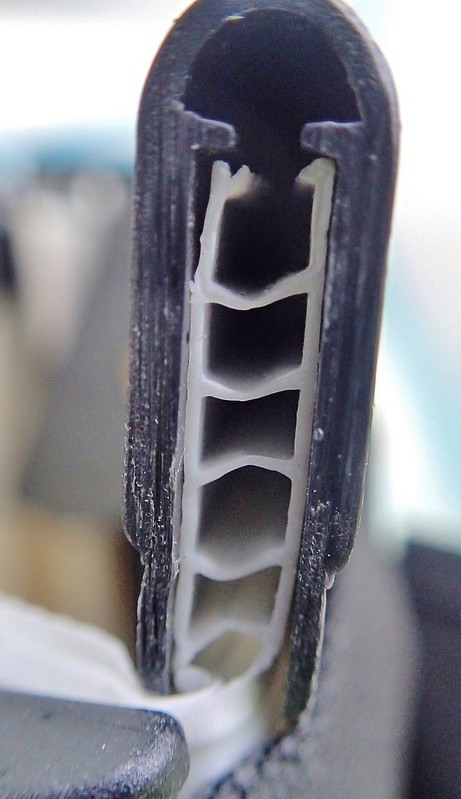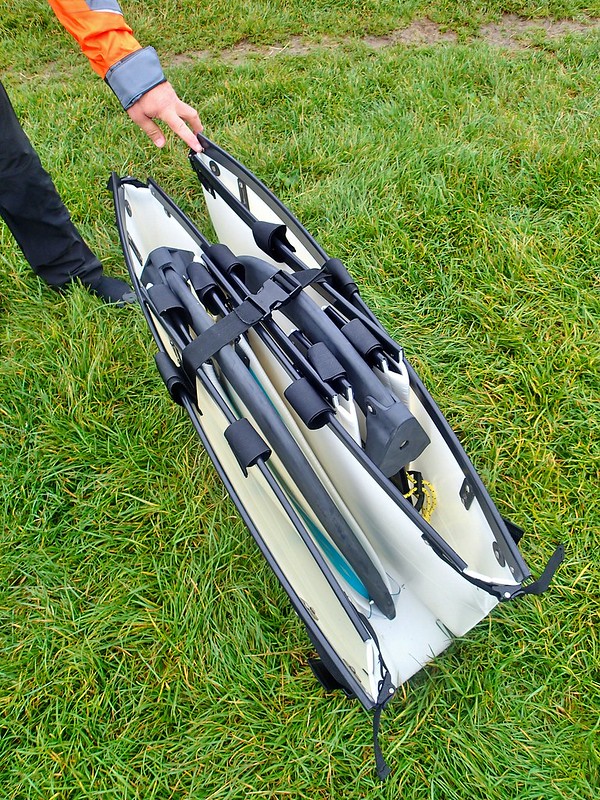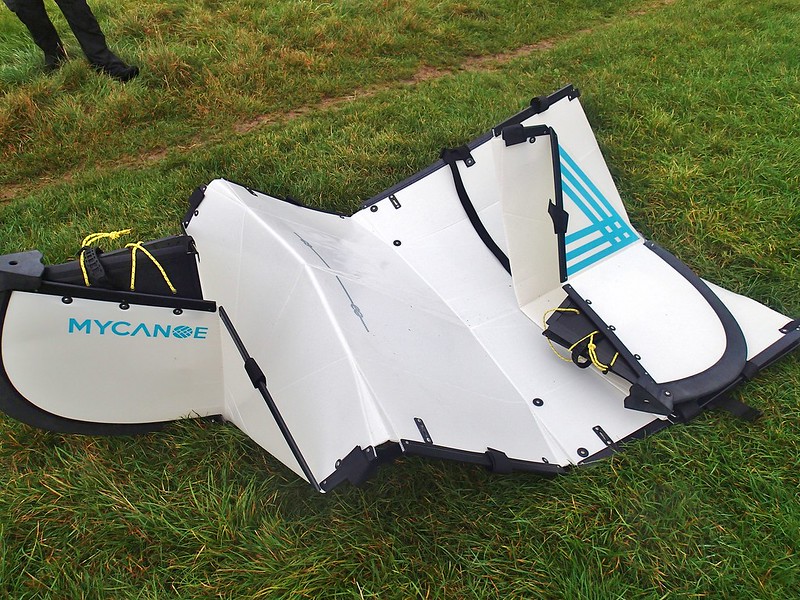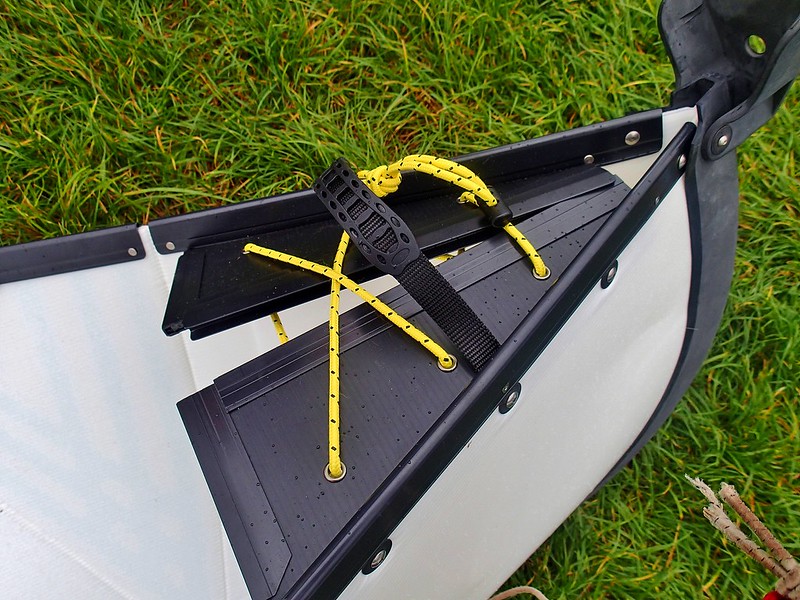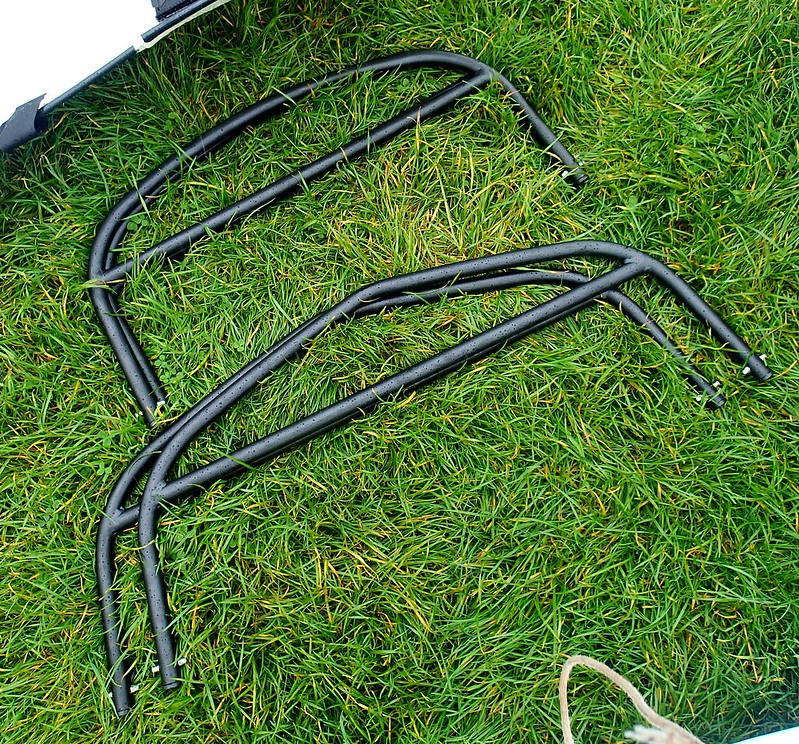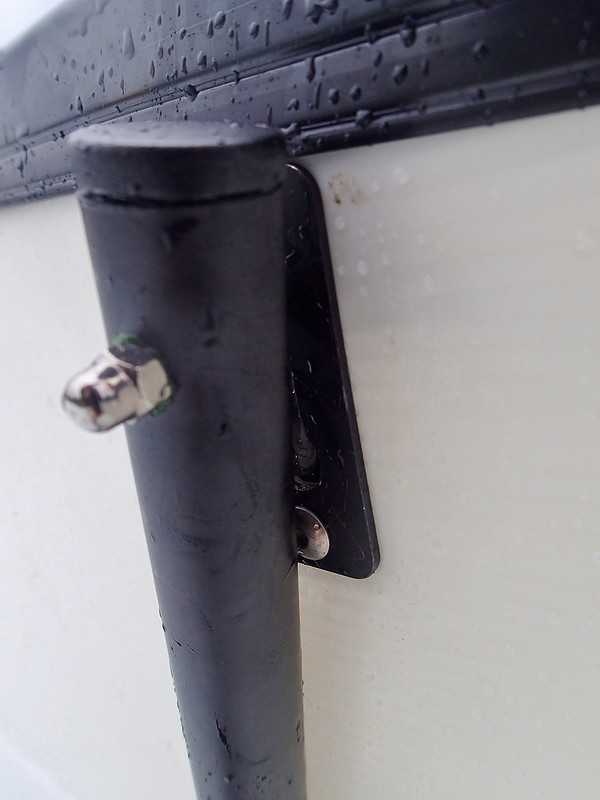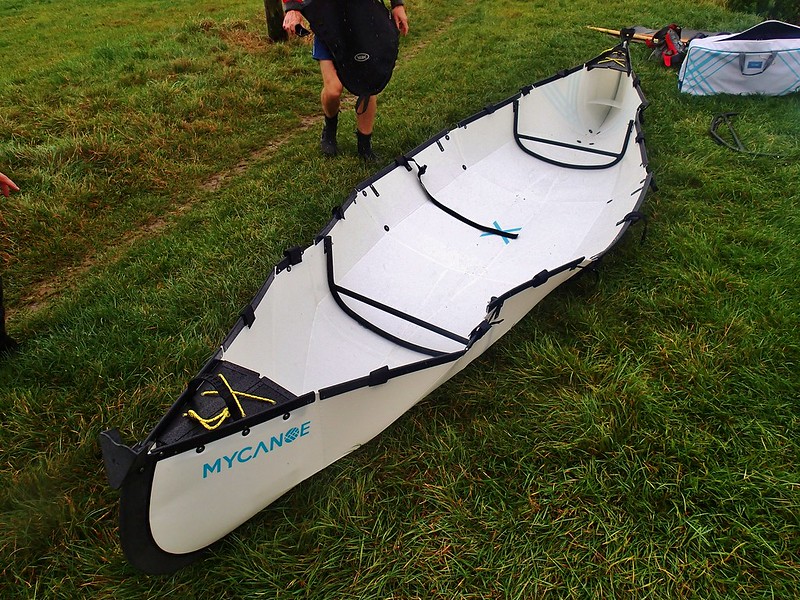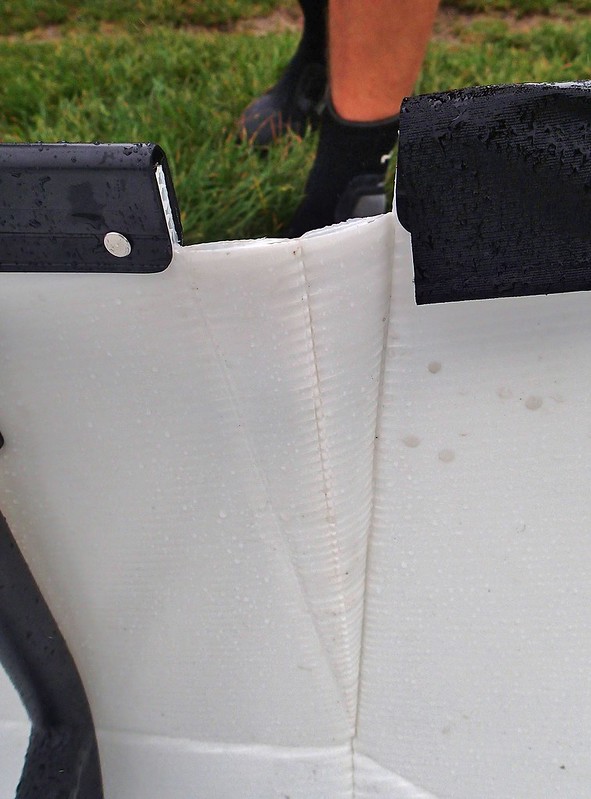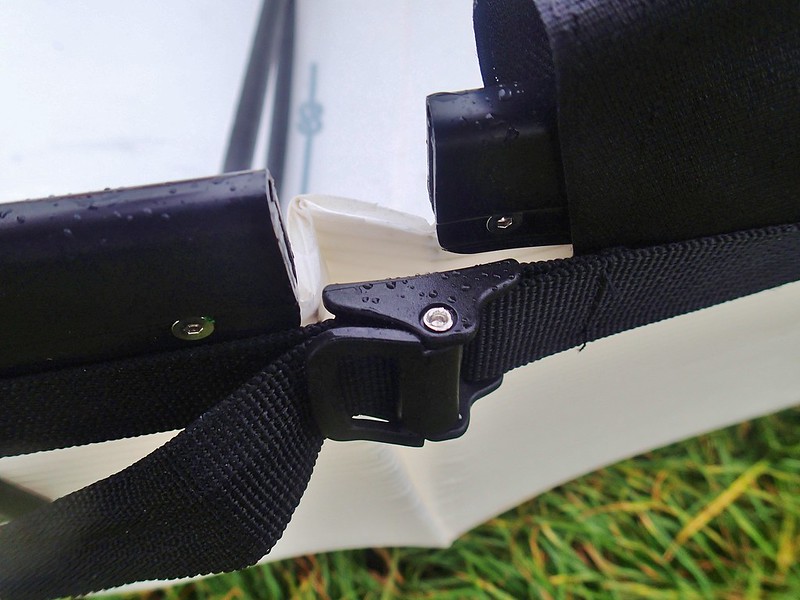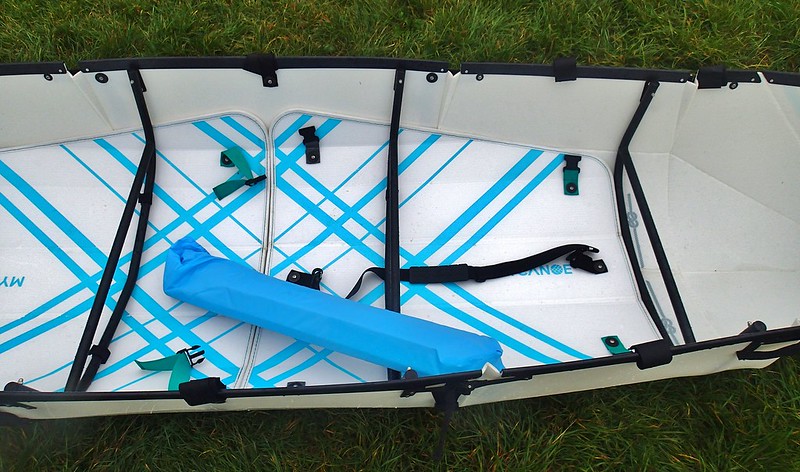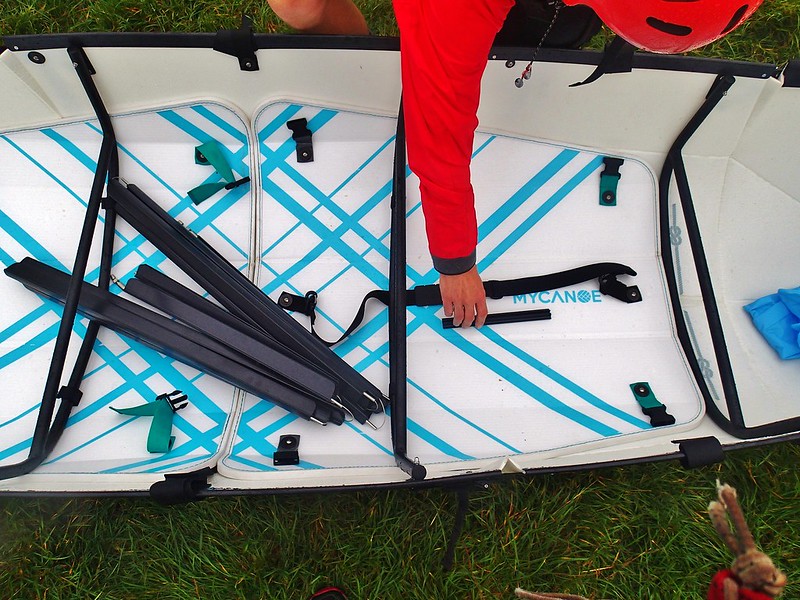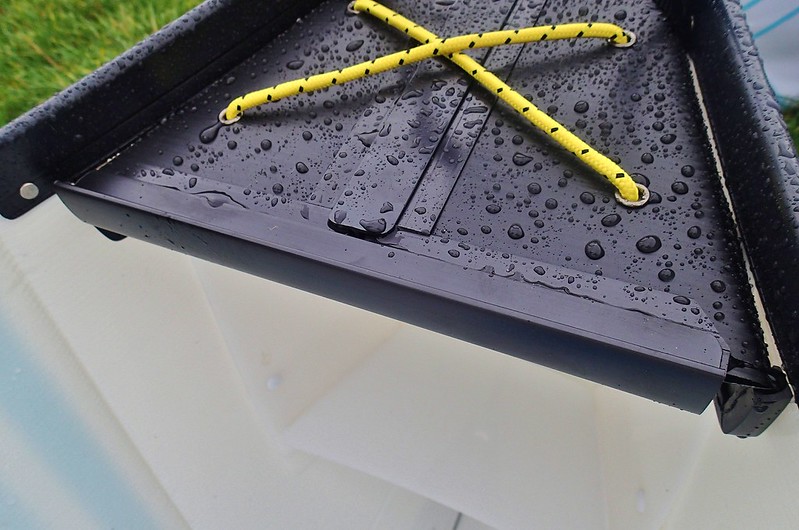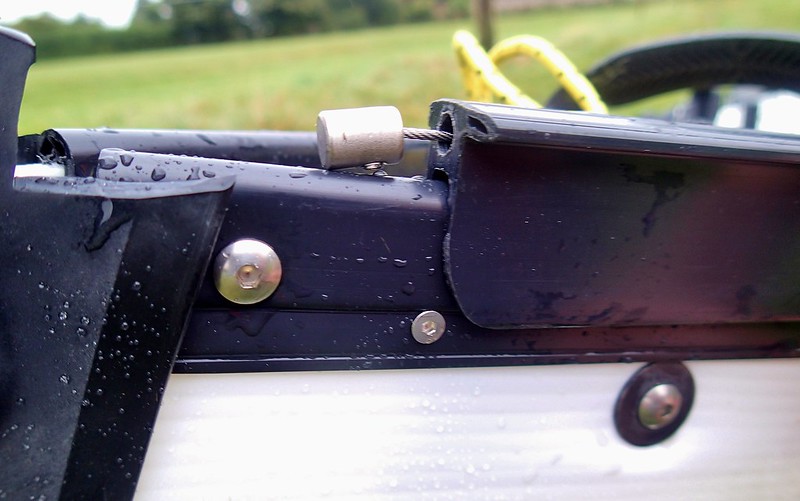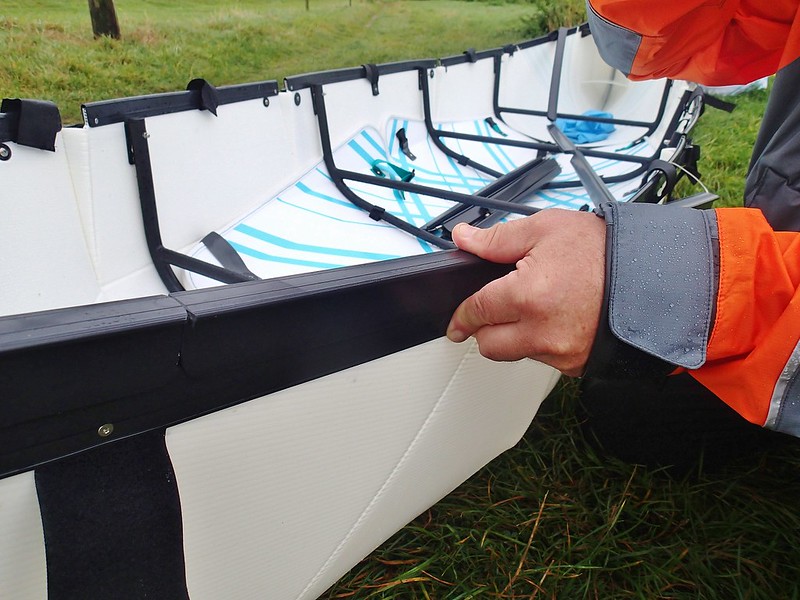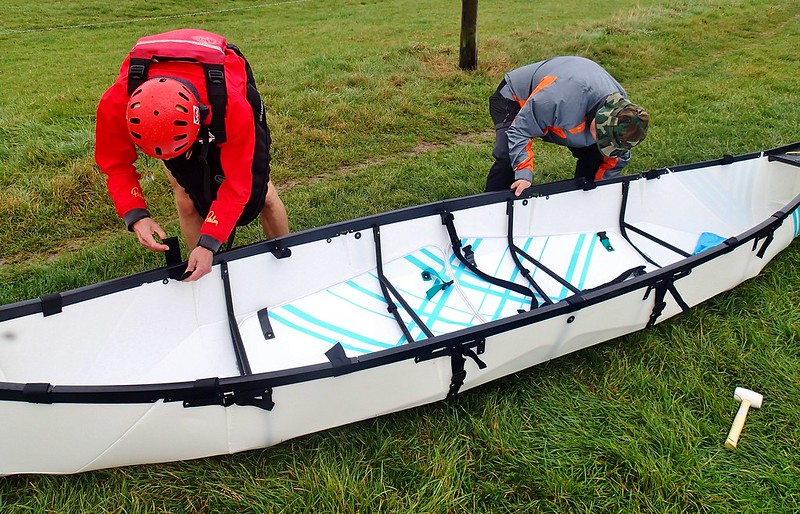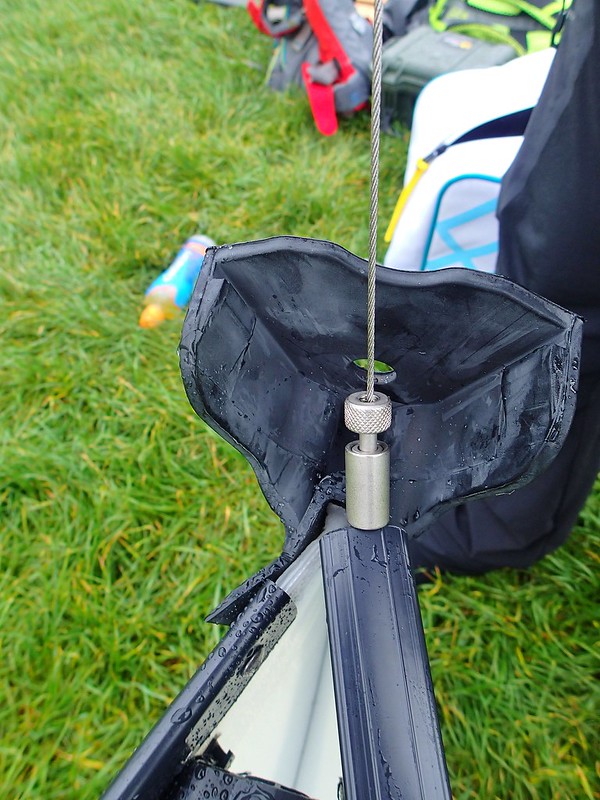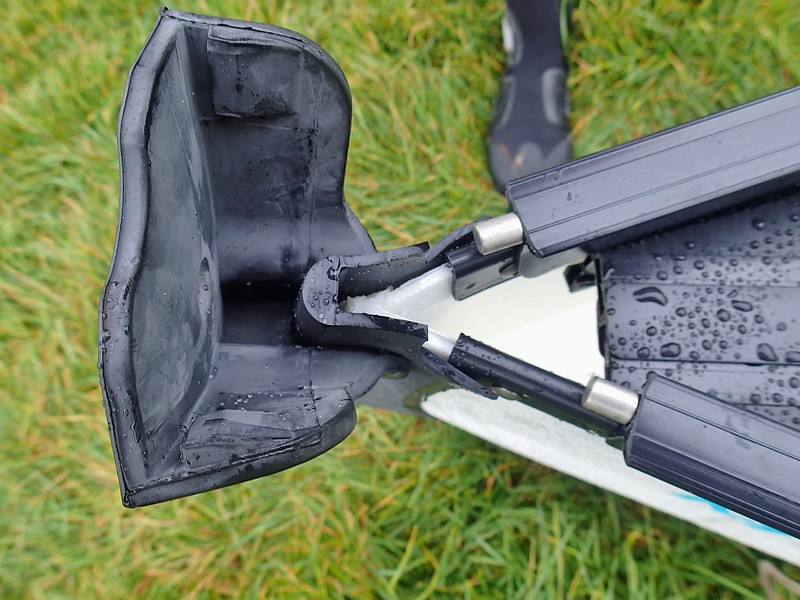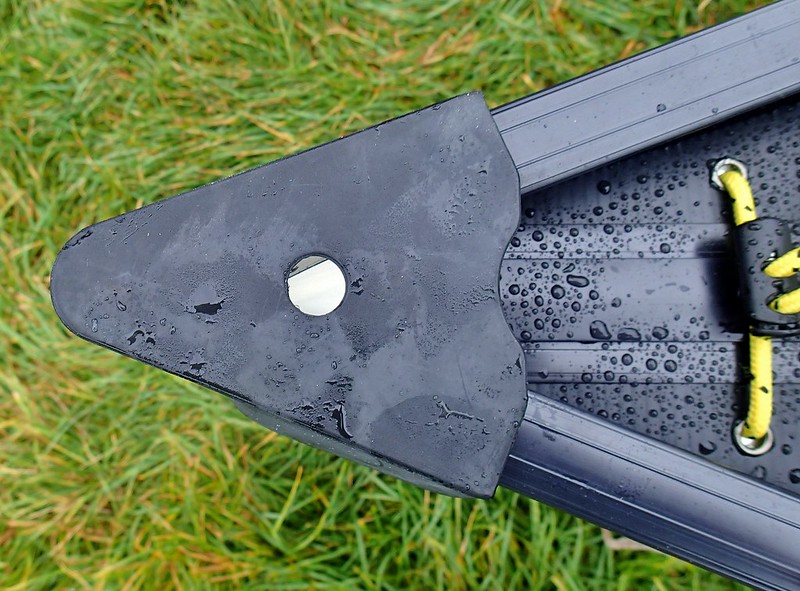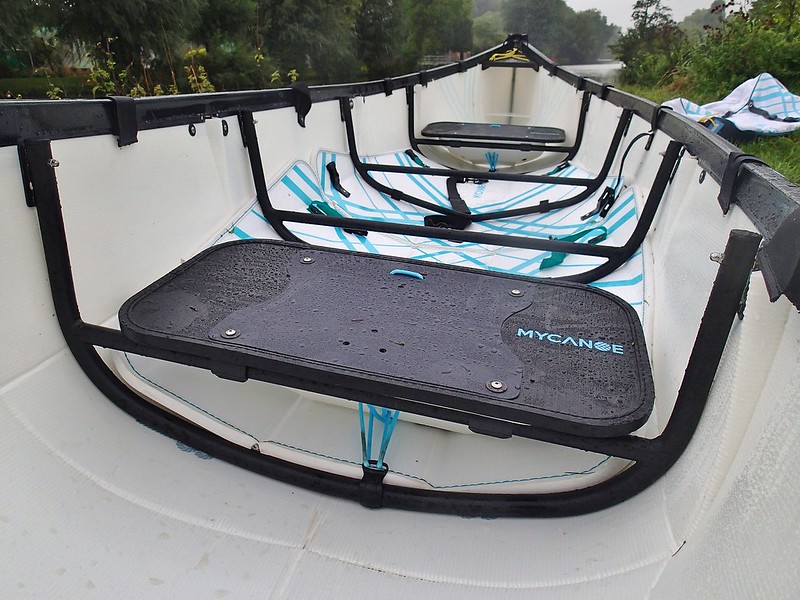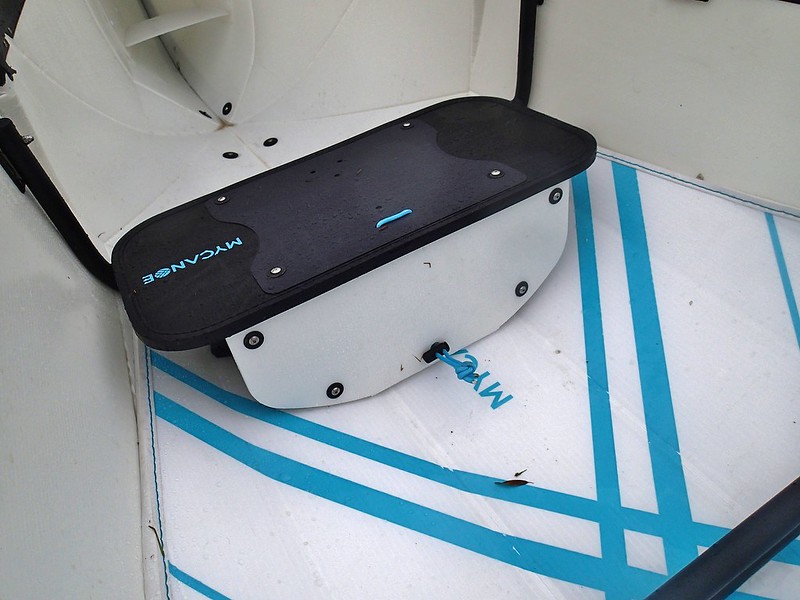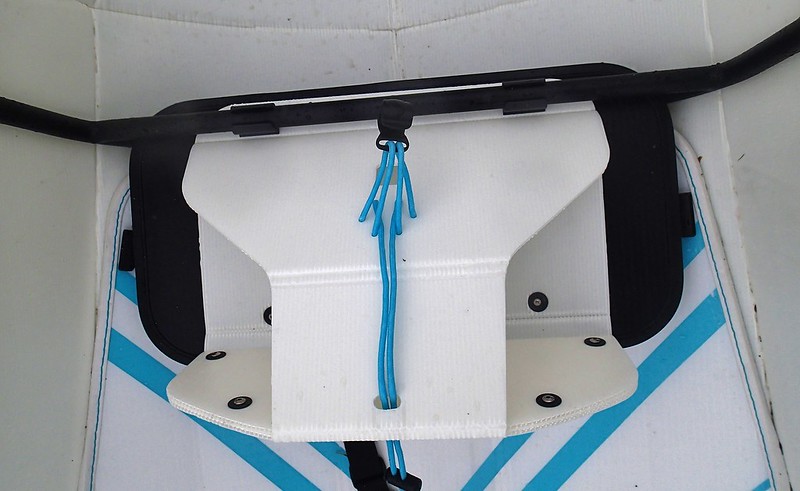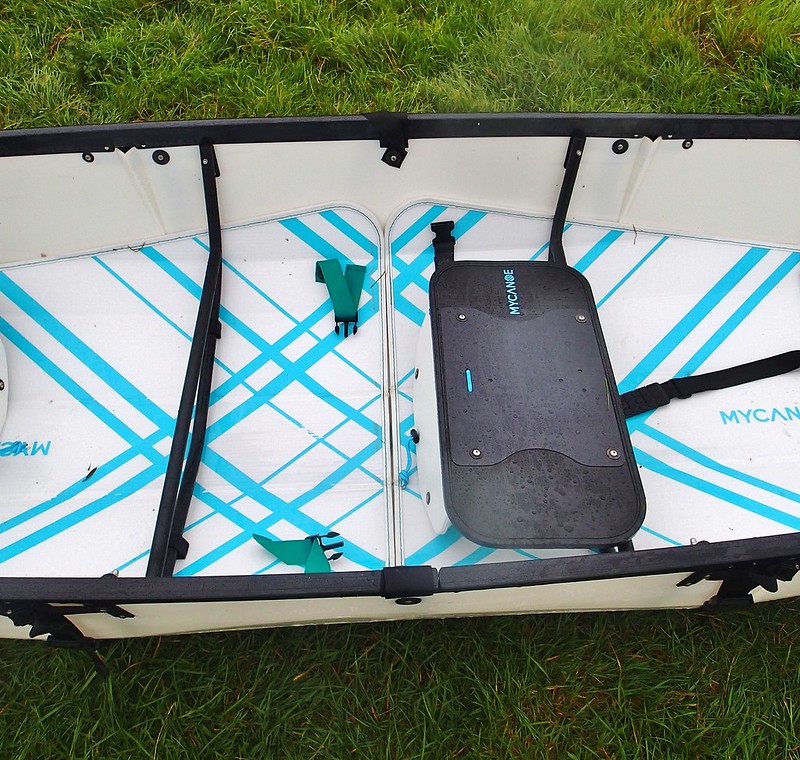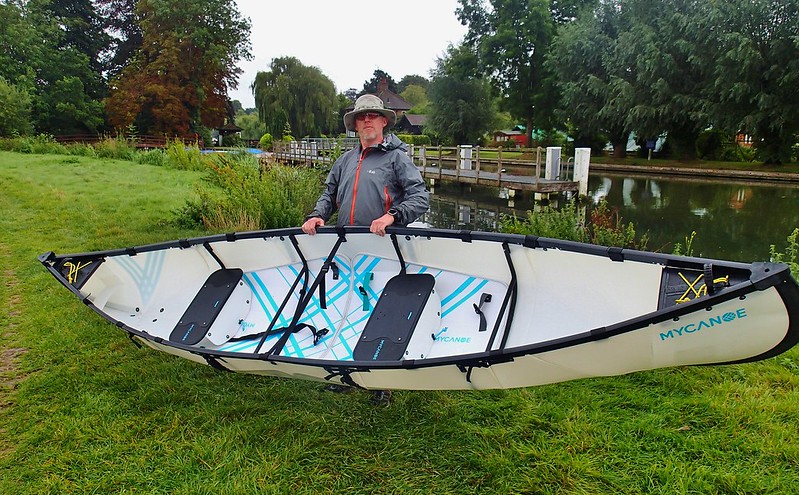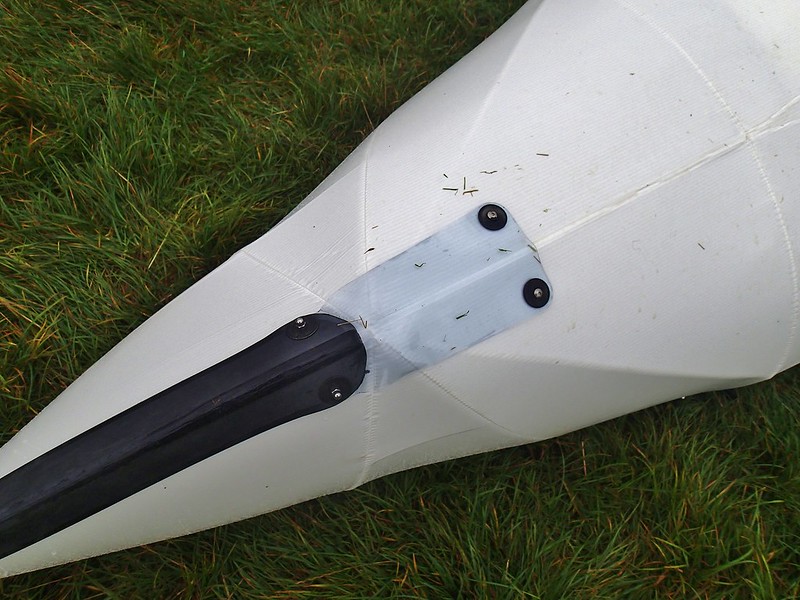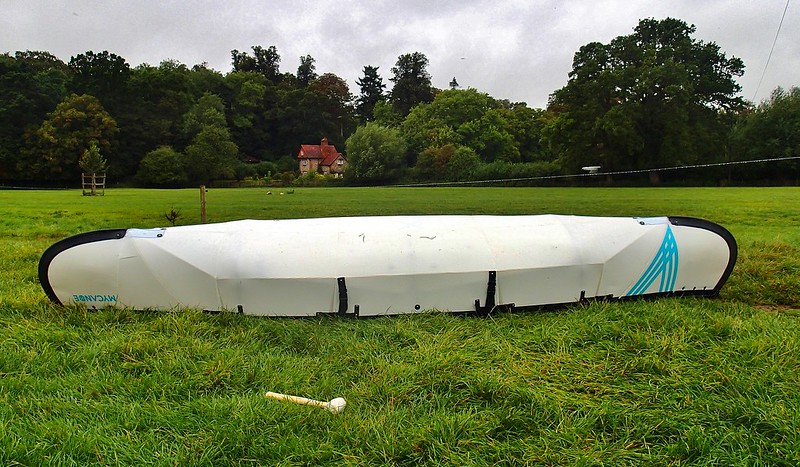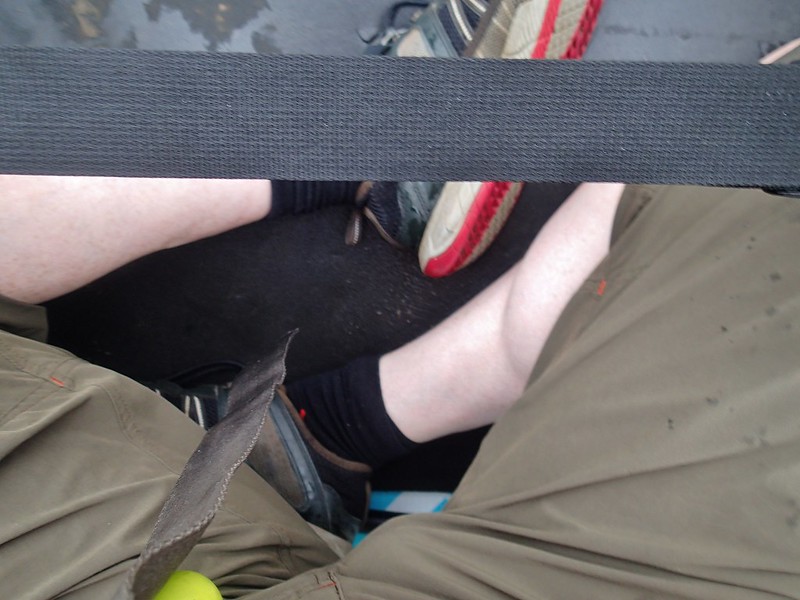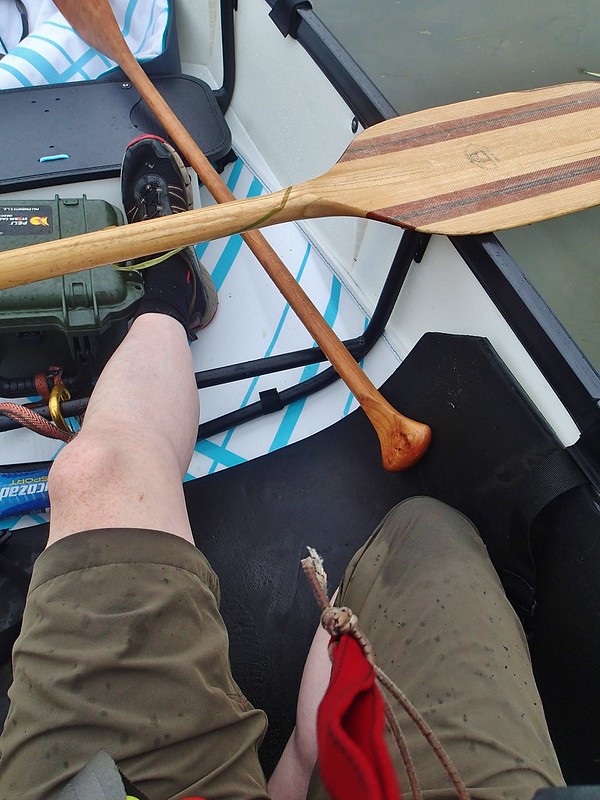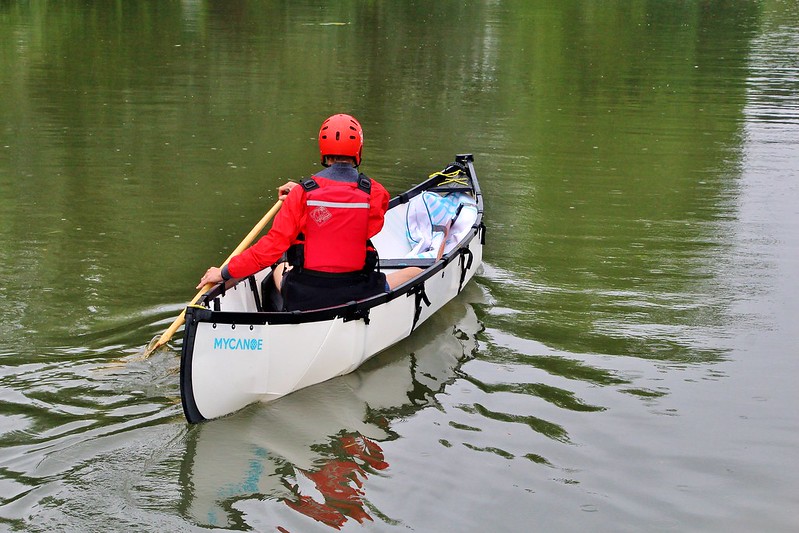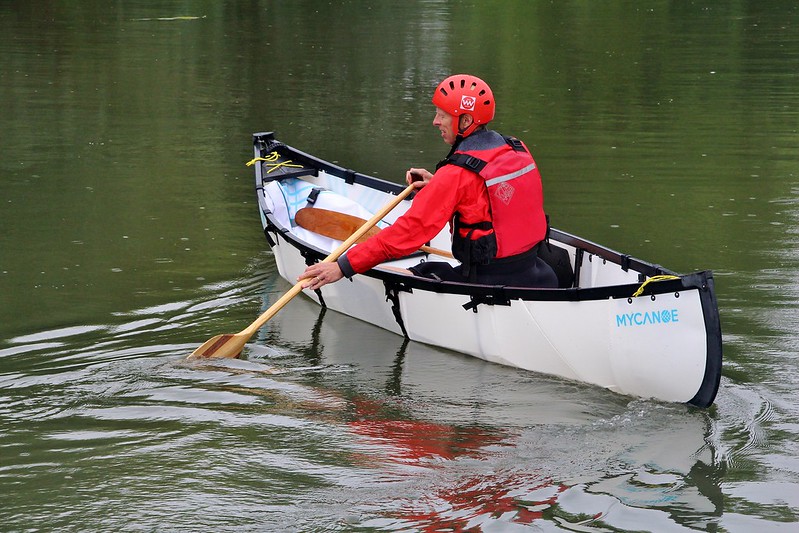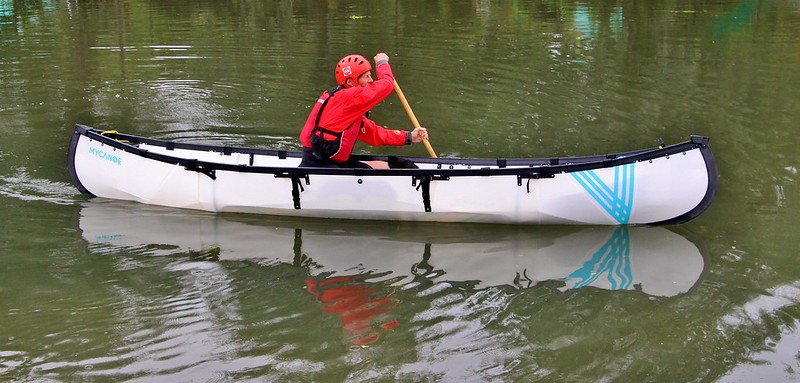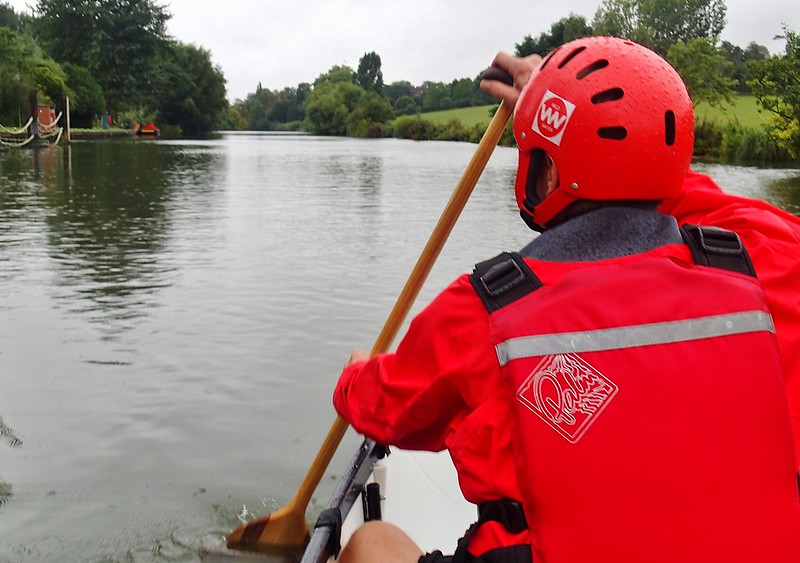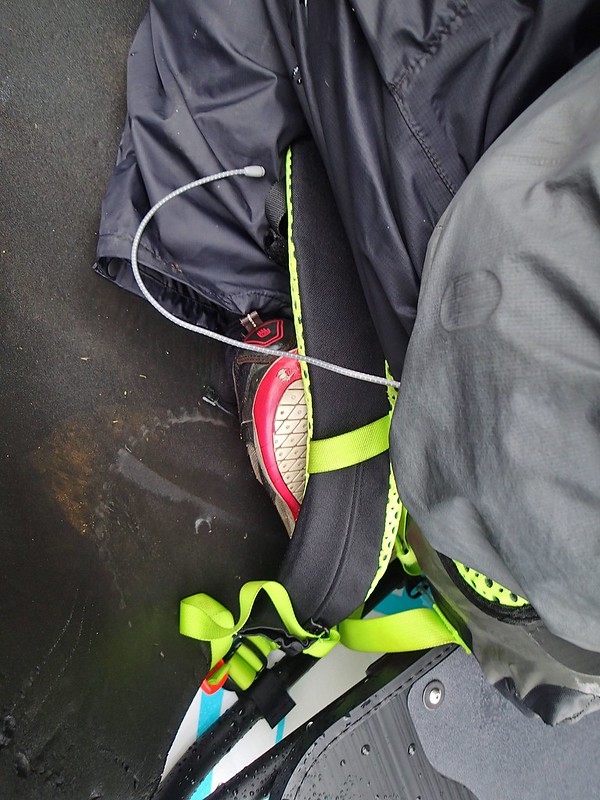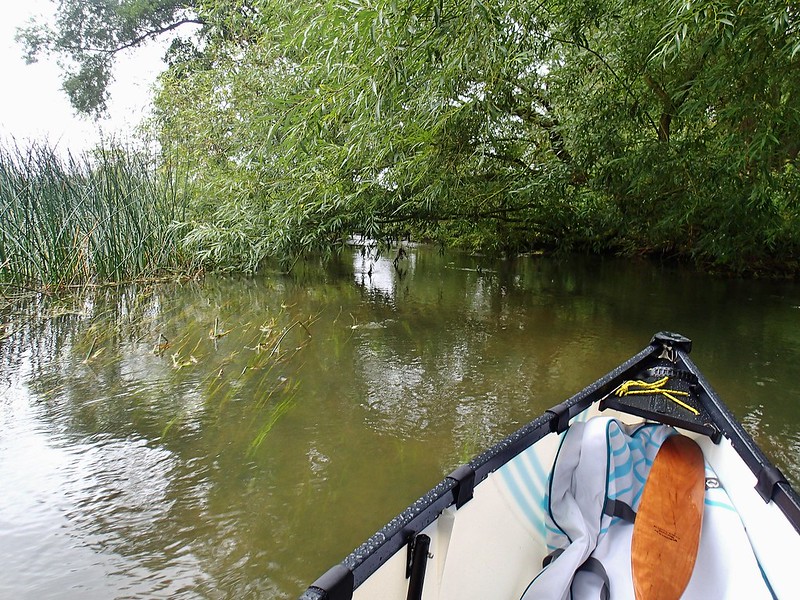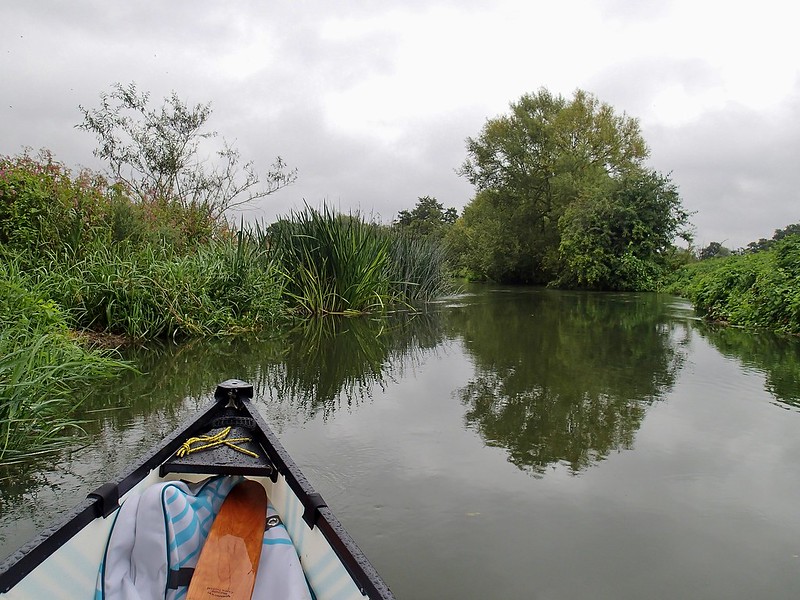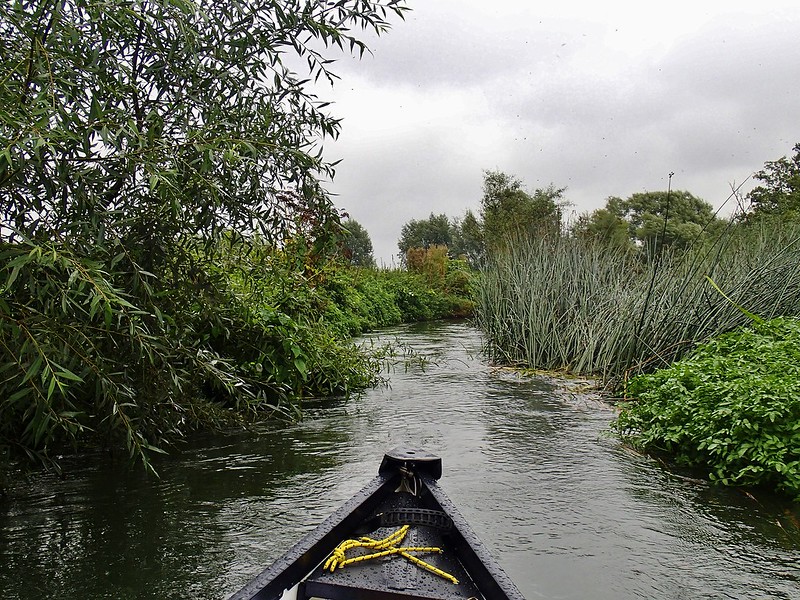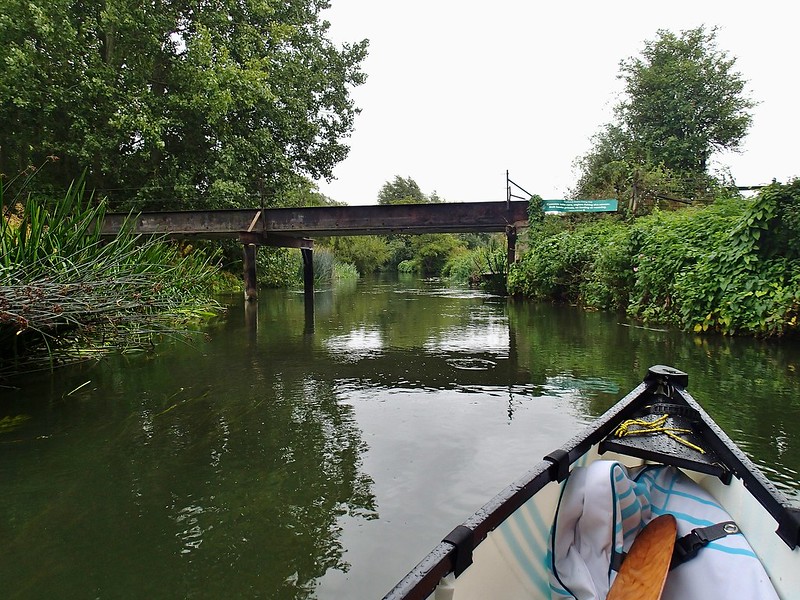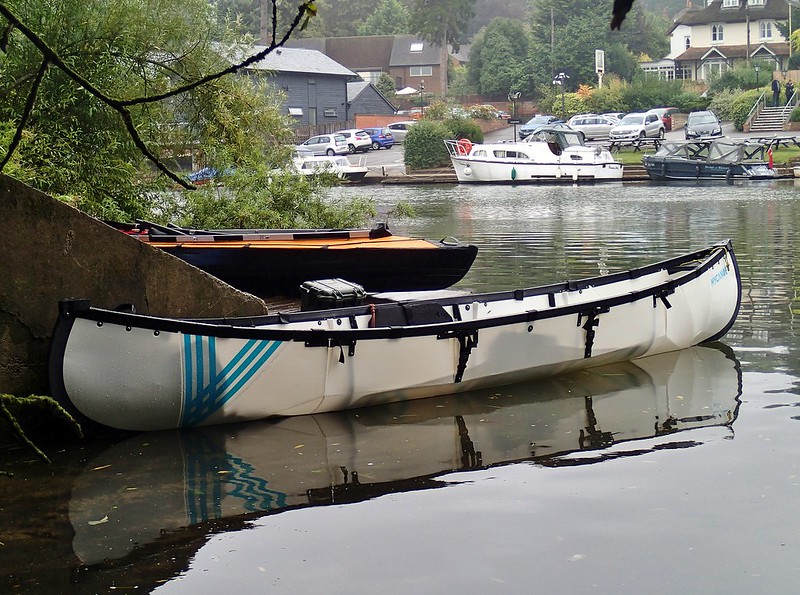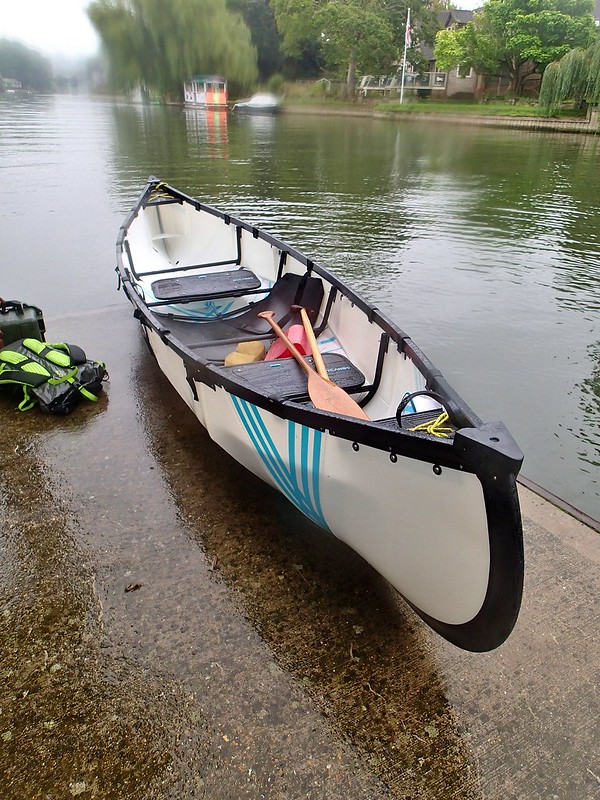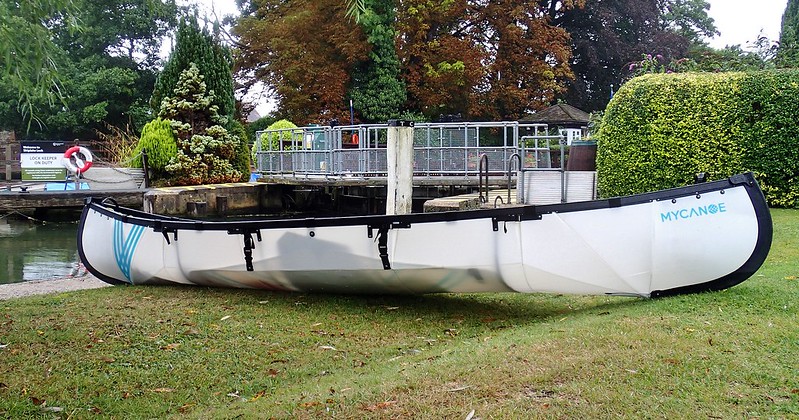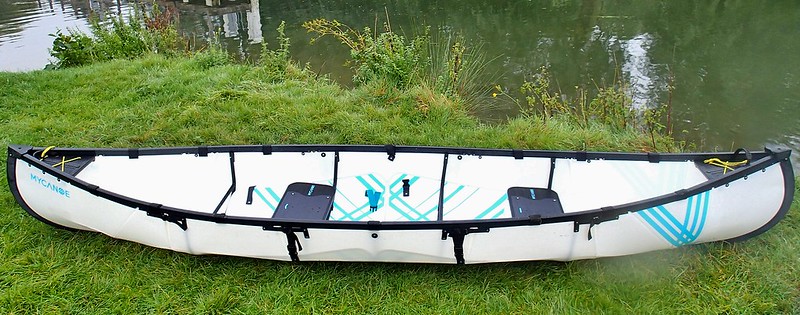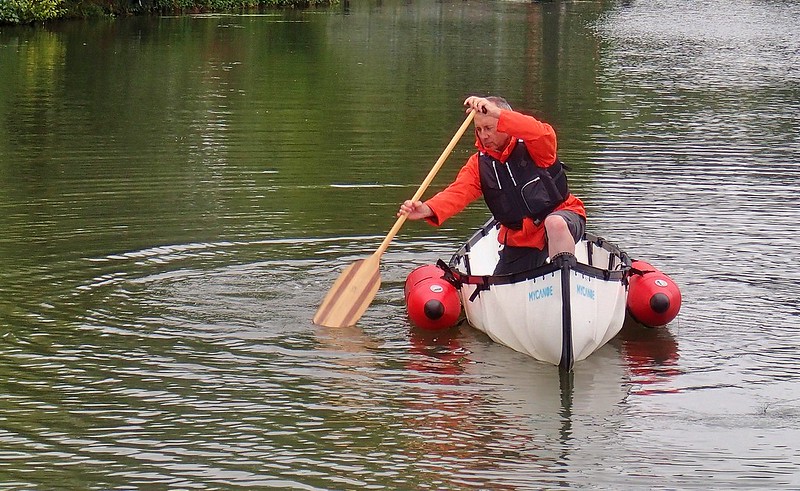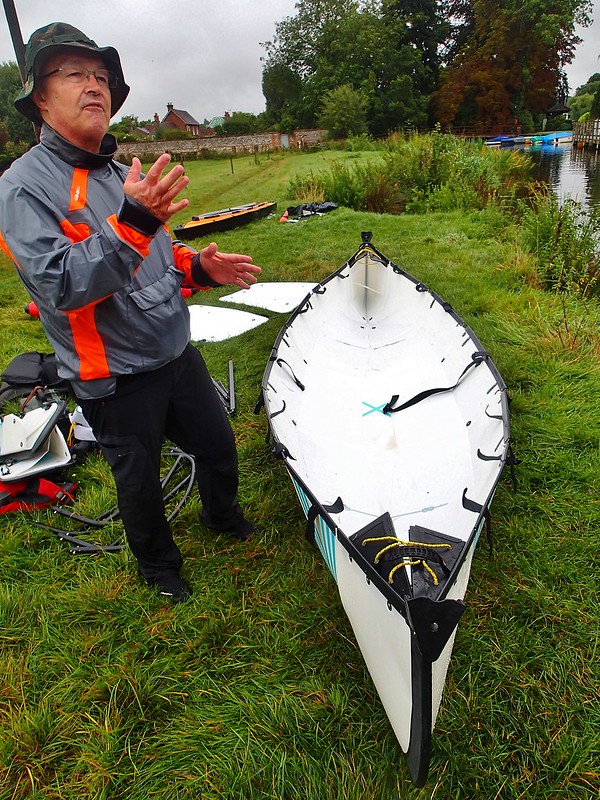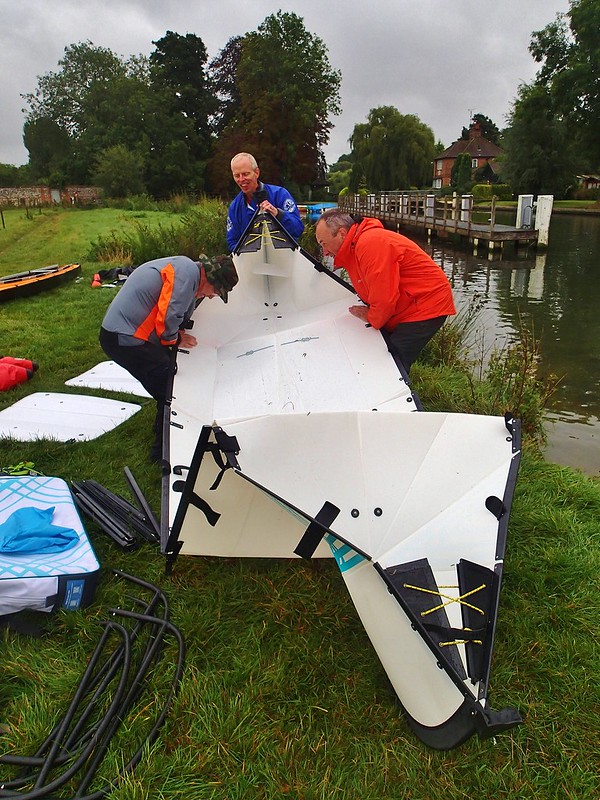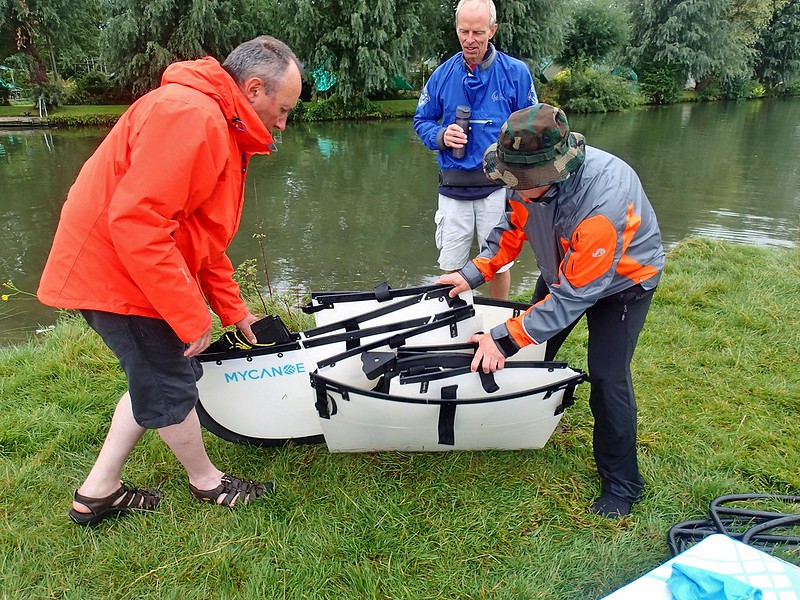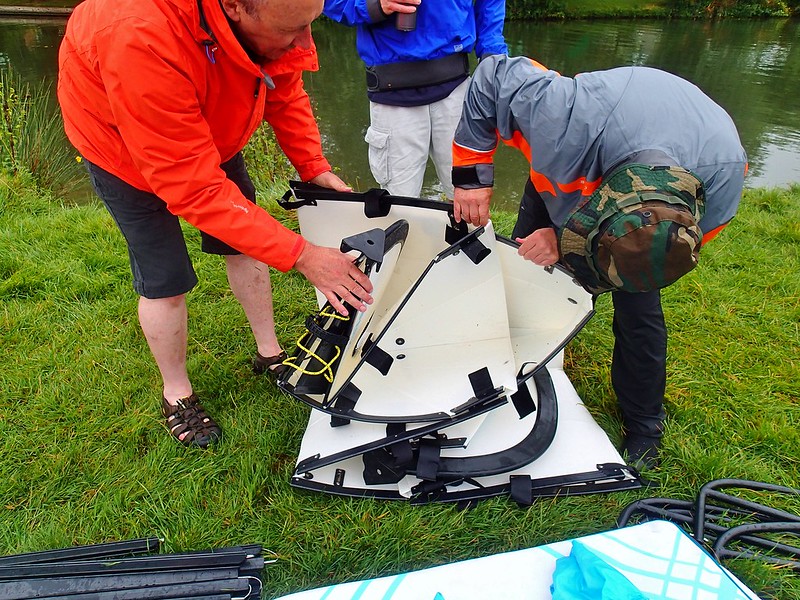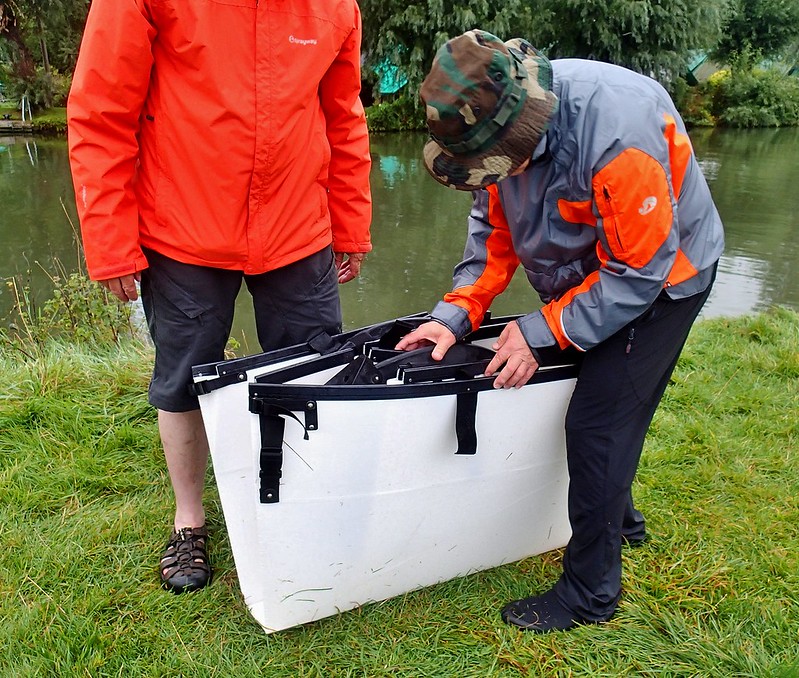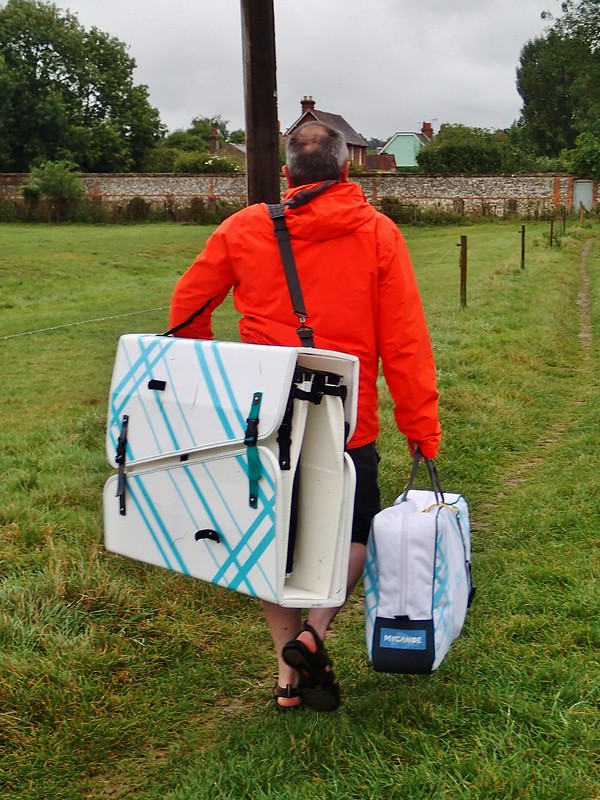Your Cart is Empty
Some weeks ago, the chance came up via the SOTP Facebook site to test out a different type of folding canoe, the MyCanoe. I jumped at the chance to try a variation on a theme, as it is quite different to my Ally DR15 Folder with its rods and struts skin-over-frame construction.
The MyCanoe is described as an origami canoe. And it does indeed resemble a paper model, thanks to its single folding skin nature. It’s a 14’ tandem canoe, though I would mostly be trying it solo – which to be fair to the canoe is probably something that hasn’t really been thought about.
They are made from a custom polypropylene fabric, which does look a little like plasticised cardboard, but is far better than that! This is UV treated to last 15 years, and is tested to fold 20000 times. There are 4 metal cross pieces, and a stiffened gunwhale to hold the shape.
Uniquely amongst canoes, as far as I know, the MyCanoe has adjustable rocker – “gussets” in the side can be adjusted with straps. Open them out, and the ends will drop leaving almost no rocker but good straight line tracking. Close them by tightening the straps, and the ends will lift slightly, offering a moderate rocker to easy manoeuvrability.
The shape is very much that of a true open canoe.
OK. So, I posted a thread on SOTP to see if we could get a small group together and combine a test with a paddle of St Patrick’s Stream, one of the loveliest backwaters of the Thames. Unfortunately, the weather gods weren’t on our side, and with a rainy forecast, a few folk dropped out. So it was just my mate Pete, in a kayak, and myself who met Simon at Mill Lane, Shiplake, on a wet Saturday.
When Simon opened the back of his van, which was full of a variety of interesting folding craft of all shapes and sizes, he pulled out a couple of modest sized “boxes”. The canoe comes in two bags; a smallish padded one which holds the cross-pieces, gunwhales, seats and pleasingly a rubber mallet; and a larger “box” which holds the skin of the canoe. The outer part of the box actually forms a reinforcing floor within the canoe.
Padded bag
Main box
The big box is about 94 x 63 x 20cm, the padded bag 88 x 40 x 18cm. Combined, they weigh about 25kg.
The box is held together by quick release buckles, and when undone, the 2 parts come away and become part of the internal floor.
Before we start the build proper, a little more about the fabric. This polypropylene board should sound like the weak link, as it resembles the sort of thing used for display boards etc, but it actually feels tough and strong, and as mentioned above, is fold-tested thousands of times more than you’ll ever need. There’s a simple repair kit should you manage to puncture it, but that seems unlikely unless you really mistreat it, and its basically just tape to cover a hole.
The Build
And so to the build. Having opened up the box and put aside the 2 floor pieces, we started to open out the main skin of the canoe. I should point out that there were 3 of us, though Pete and I did most of the work under occasional direction from Simon. However, we took it really slowly, so I could record the built.
First, a buckled strap “releases” the skin. This then becomes the closest thing it has to a central thwart once finished.
The skin is then pulled out into the approximate canoe shape.
The first part to assemble is the stems, where a folding brace-piece slots simply in around waterline level, and then the end “deck” folds into place and is pulled taught by simple elastic bungees.
Now for the bit that felt more familiar to me as the owner of an Ally folder – the cross-struts. On the Ally, there are 7 of these. The MyCanoe only needs 4. They’re also easier to insert into place, having a simple bracket to click into on the inside of the canoe below the gunwhales. You then simply push them downwards and into place, using the mallet as required.
You start with the “outside” cross-struts, which are smaller, and stored in a labelled slot within the bag.
With the first two in place, we could then chose our “rocker”. Tightening the strap on the gunwhale closes the gap and lifts the ends of the canoe to form the rocker. 5-6cm is claimed to be possible, I’d say that, with brand new stiff fabric, we struggled to get quite as much as that as the “gusset” was hard to close completely.
In go the two floor pieces (that formed the box) with the patterned side upwards to allow the use of the attached Velcro straps to line up and secure the two larger central struts which go in next.
Now we reached back into the padded bag for the blue drawstring bag containing the gunwhales. Linked with a tough flexible cable, these resemble those sliding black plastic “clamps” that you run down the spine of a sheaf of paper when producing a presentation or something.
Two short pieces slot over the end plates to complete those.
Now we started to put the first gunwhale on. Working from one end, we slid the plastic gunwhale over the reinforced edge of the canoe’s skin. At each joint, a small metal piece slots from one section to the next. A little care is needed to make sure these slide into place without bending them.
Velcro straps further hold the gunwhales down. The second soon followed the first.
At the ends, you pull the cable tight, tighten a sliding stopper, and tuck it all under the end plates, which are then covered by a further rubber cap.
We were pretty much there now, and the MyCanoe was really looking the part. We now needed to add the seats. These are a solid flat seat, sitting on a folding parts which clip onto the cross-struts at one side, and then with a bungy from the other side. You can flip these around to be either side of each strut, or move them between struts. This gives excellent flexibility of seating and trim for a tandem pair. It also allows you to position one seat quite close to the centre for a solo paddler – more of this in a bit.
OK, we were done. What we now had in front of us, was a proper, rigid open canoe. And it didn’t weigh much. The build had been pretty straightforward, and would quickly become easy, and I have no reason to believe you couldn’t quickly get it down to the quoted 10 minutes as a pair, 15 minutes solo perhaps. It had taken us half an hour, with lots of stops for photos and to listen to Simon’s descriptions of why things were designed as they were.
OK, there’s probably more flex than the Ally folder, which has as said 7 cross-struts, plus 9 chine rods/gunwhales, but that takes up to 4 times as long to build, long enough to be off putting for day-only trips. The MyCanoe is quick to put up, a definite positive there. The hull has a definite proper canoe shapes, and comes complete with reinforcing skid plates at each end. These will help when landing or putting in, but I still wouldn't want to drag the canoe over any rough surfaces.
On the water
OK, now time for the acid test – how does it feel afloat. I’d set up the seat just behind the middle.
There’s an optional webbing strap which can go across right where a yoke would be on a normal canoe, but this didn’t really add any rigidity so I unclipped it so I could sit more centrally.
You’ll notice I say “sit”, and many will know I’m a kneeler when it comes to paddling. The seat is effectively solid, so you can’t kneel with your feet beneath it, so I set up with one leg outstretched and one tucked across. Later I would try my bag as a kneeling saddle.
Now afloat, it was time to give her a bit of a test. Primary stability was reasonable, a little twitchier than my Prospector or Ally, but typical of a decent stillwater canoe. Secondary stability is excellent, once leant over it finds a nice balanced position, and pushes back if you try to lean further. I got myself comfortable, and started paddling. Immediately it was clear that this was a genuine canoe, and handled like one. It tracked well (remember you can reduce the rocker too), and in a straight line got up a decent speed. It seemed to glide better than the Ally folder, though I would not claim it to be as fast as a stillwater solid open canoe. Pete also had a go, so you can see it in action better.
I heeled it over as best as I could seated, and tried to spin it. Not bad at all, again it handled like a “real” canoe, not as easy to spin as my Ally or most Prospectors, but comparable I’d say to the likes of Mad River Reflections, Pals, Mega Outlanders, Apaches etc etc.
So, initial solo impressions were good, just needed to think about the seating.
Next, Pete and I jumped in for a go tandem. And for this the seating was good, and the canoe handled well. We got up to quite a pace, definitely faster than the Ally.
Meanwhile, Simon had been building his own kayak, an impressive beast in itself. It was time for our paddle to start. I’m not going to blog this properly, it was pretty wet and miserable, so we just got on with the paddle up the Thames. I was back to solo paddling now.
It was slightly weird being able to see the water line through the fabric!
Paddling upstream the MyCanoe continued to perform well, it wasn’t feeling like a folding canoe any more. When we turned down St Patrick’s stream, I tried using my dry bag as a kneeling saddle, with the back perched on the edge of the seat. This was a vast improvement on the half-sitting/half kneeling position I’d been using, and it really made the canoe come alive. Partly this was just because I always kneel, but it proved to me the canoe is genuinely capable of being manoeuvred easily.
Meandering down the Stream, I was enjoying being out on the water, and the MyCanoe was working just fine.
St Patrick’s Stream was as lovely as always, and then we drifted down the Loddon to the Thames. WE then headed downstream for 10 minutes, before pulling over to grab a bite to eat.
We decided not to go any further, and do the Hennerton Backwater, so headed back to the start via the short portage of Shiplake Lock. Here we met Richard, a paddler from the Marlow Canoe Club, who would collect the canoe for its next test the following day.
OK, so the paddling was over. My conclusion is that it paddles well, like a solid open canoe, if just a little slower. Its faster than any inflatable I have paddled, and can be heeled over to improve turning. On still water, it beats my Ally folder for performance, though the latter is designed to also go down rivers with a load.
I can’t comment as to how it would perform in waves, but my instinct is that it would be fine, if more flexible than the Ally.
Its not designed as a white water river runner. It would be fine on grade 1, and confident paddlers would no doubt get it down much harder, but its not expected to be bouncing off rocks and shallow sections.
Capacity wise, it can take something like 240kg, though the suggested load max is 200. This would mean 2 adults and a kid, or 2 and bags. So for canoe camping trips, you’d be a little limited for gear if both paddlers were fairly heavy.
As mentioned, and in common with many tandem canoes, it doesn’t come set up for solo paddling so you’d need to think about it. The seating is good for most tandem paddlers, and therefore I would imagine a large number of prospective buyers wouldn’t have any problems with them.
Stabilisers
There are some inflatable stabilisers available as an optional extra, which just clip on. These are designed in particular for folk like fishermen who need to stand, but would also increase the weight capacity. We tried them out quickly, and standing up was certainly fine with these. They get in the way for solo paddling with a single blade, of course, but paddling from stern and bow wouldn’t be badly affected.
Packing away
This was basically just a reversal of building it, but faster.
The fun bit is, of course, getting the knack of getting the fold right. Entertaining for the photographer. You’d soon get the hang of it.
Soon we were done, and Richard marched off with the canoe. Its very portable.
Availability and pricing.
Simon of Folding Kayaks UK is looking to import in batches, as its such a new product to the UK, so its not yet available “off the shelf”. Nor are the other obvious folders, I had to import mine myself.
The guide price is £1300. Simon is looking into possible opening offers for SOTP members, and will no doubt post about these soon.
Conclusions
This is an impressive piece of engineering. Its quick to build and pack away, and on the water performs really quite well on still and slow moving water. Tandem its ready to go if you don’t generally kneel, solo you’ll need to adapt something to make yourself comfortable if kneeling.
I could imagine this being an excellent choice for somebody considering an inflatable, but wanting a canoe that performs like a solid open canoe. As its so quick to build, day tripping would be easy, whereas with my Ally, it takes out quite a chunk of the day. It would also be excellent for folk using a campervan and wanting to take a canoe.
It performs well in many paddling conditions, though I haven’t tested it in strong wind (the light weight would probably mean it being a bit wind-affected, but not badly), waves or moving water.
Its hard to comment on ultimate durability, but its well made, the parts are tough and close fitting, its easily patchable if you manage to puncture it, and the “fabric” is pretty tough. Its not a cheap canoe, and nor does it feel like one, it’s a proper bit of kit and I would expect to get years of stillwater paddling out of it with a little care. For more serious expeditions flying to remoter parts of the world, I am happy that my Ally is the better choice for me; though it doesn’t paddle as well as the MyCanoe, its larger load capacity and rigidity for portaging are something I prefer. I am, though, probably not typical of the sort of customer who would consider this canoe.
If I were wanting it mostly because I didn’t have space at home, had difficulty car-topping the canoe, wanted to travel on public transport in the UK etc, etc, this is a real alternative to inflatables and to other folding canoes. In particular, the way it paddles is in a different league to most of these.
It’s a very clever canoe.


